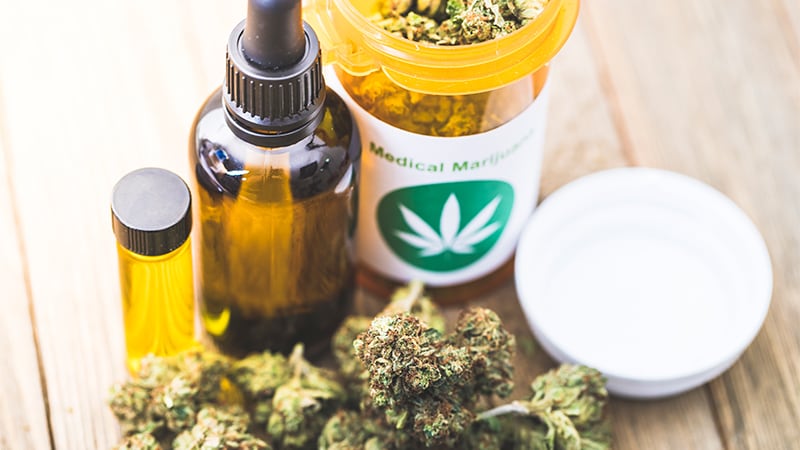What is the role of cannabinoids as an intoxicant and in medical applications today? This was the question addressed by Dieter Braus, MD, psychiatrist and neurologist at Vitos Clinic Rheingau in Eltville, Germany, at the DGIM Congress 2022.
Dampening the Dopamine System
Regardless of the type of substance-dependent addiction — whether alcohol, opiates, nicotine, or cannabinoids — the brain pathway is the same: the dopamine system. This system is also responsible for curiosity, desire, learning, and actions. Various substances lead to increased neurotransmitter release.
The endocannabinoid system acts as a damper on this system. System stabilization is inhibited by the high-affinity binding of delta (9)-trans-tetrahydrocannabinol (THC) to CB1 receptors. The psychotropic component of cannabis naturally accounts for 1%–2% of the active substance. However, this proportion has now increased to 10%–20% as a result of selective breeding. At the same time, the proportion of cannabidiol (CBD), the nonpsychoactive counterpart, has fallen.
In addition to the acute THC effect with a high and pleasant feeling, chronic consumption produces different effects. Retrograde signaling pathways are disrupted, leading to addictive behavior, reduced motivation, and negative emotionality. These chronic effects may even occur after only a few instances of consumption.
Deep brain regions, such as the hippocampus, substantia nigra, amygdala, and hypothalamus, have the greatest densities of CB1 receptors. These regions are all involved in stress-related illnesses, including anxiety disorders, depression, and obsessive-compulsive disorder.
Psychosis Risk
Cannabis consumption may lead to impaired cognition, reduced motivation, and psychosis triggers because of an imbalance in important systems, especially if cannabis is consumed during vulnerable brain development phases.
Daily cannabis consumption leads to a fivefold increase in the risk of developing a psychotic disorder. Several countries have seen a strong increase in psychoses after legalization. For this reason, Braus expressed a critical view of legalization.
He advocated for a minimum age of 21 years for legalization because consumption before the age of 18 years has severe effects on the development of the dopaminergic system. Use during adolescence has significant effects on cognitive performance as an adult.
It leads to attention deficits, high distractibility, lower learning ability, impaired verbal expression, and issues with math and other memory functions. Even after just one or two uses, structural changes can be detected in the brain, and particularly in the medial prefrontal cortex.
This adverse brain development contributes to the formation of anxiety networks, with increased irritability and a tendency toward anxiety disorders. Braus stated that it is alarming to think that 1 in every 3 10th-graders in the United States has already tried cannabis.
Use in Neuropsychiatry
As a result of the pathophysiology, the endocannabinoid system is a potential treatment target for various illnesses, pain, inflammations, depression, anxiety disorders, and cancer. Basic research has been conducted on many of these areas, but there is often still a lack of evidence.
In the largest meta-analysis to date on medical use, 79 studies recruited 6462 patients, which Braus described as a manageable number. This provided moderate evidence for the use of cannabis in the treatment of chronic pain and spasms. There is a small amount of evidence for the reduction of nausea and vomiting during chemotherapy and for weight gain, sleep disorders, and Tourette syndrome.
All applications led to short-term adverse events, including dizziness, dry mouth, nausea, disorientation, confusion, hallucinations, and metabolic disorders.
More recent reviews, for example from the field of psychiatry, have not drawn any clear conclusions, often because studies have not been methodical enough. Additionally, the number of drugs with varying THC contents makes regulation difficult.
Summary for Neuropsychiatry
Braus summarized his lecture by making the following points:
-
Legalization of cannabis is linked with increased consumption, even in older generations.
-
Particular caution is urged regarding use in adolescents (because of effects on the anxiety network).
-
The drug is associated with an increased risk for psychosis.
-
Even mild cannabis consumption at age 13-16 years is linked with a threefold risk increase.
-
Intrauterine cannabis consumption can lead to reduced brain growth.
-
There is moderate evidence on use for chronic pain and spasms.
-
There have been no conventional pivotal studies, but lots of anecdotes. However, there is great potential in theory.
This article was translated from German and was published on Coliquio .
For more news, follow Medscape on Facebook, Twitter, Instagram, YouTube, and LinkedIn

